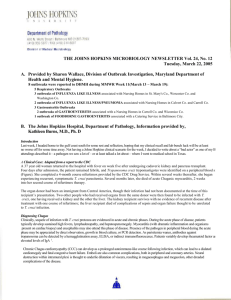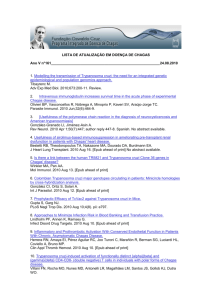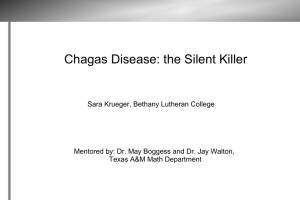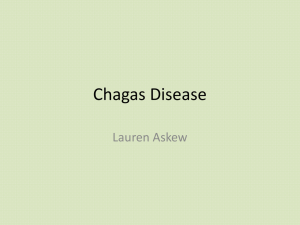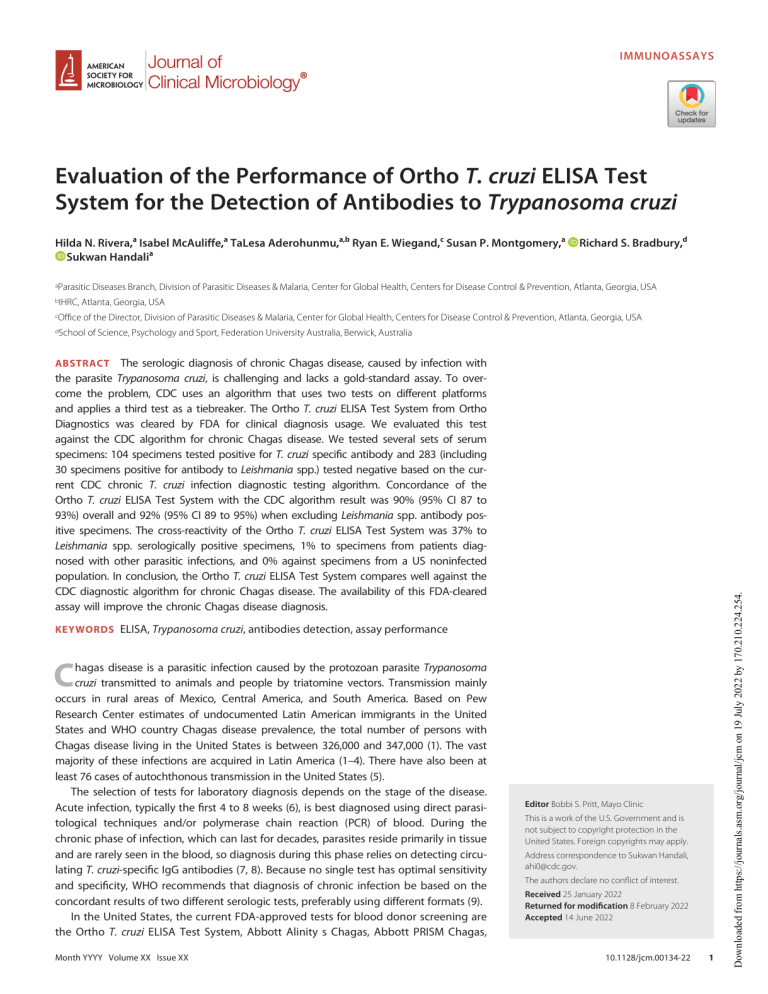
IMMUNOASSAYS Evaluation of the Performance of Ortho T. cruzi ELISA Test System for the Detection of Antibodies to Trypanosoma cruzi Hilda N. Rivera,a Isabel McAuliffe,a TaLesa Aderohunmu,a,b Ryan E. Wiegand,c Susan P. Montgomery,a Sukwan Handalia Richard S. Bradbury,d Parasitic Diseases Branch, Division of Parasitic Diseases & Malaria, Center for Global Health, Centers for Disease Control & Prevention, Atlanta, Georgia, USA a IHRC, Atlanta, Georgia, USA b c Office of the Director, Division of Parasitic Diseases & Malaria, Center for Global Health, Centers for Disease Control & Prevention, Atlanta, Georgia, USA School of Science, Psychology and Sport, Federation University Australia, Berwick, Australia d The serologic diagnosis of chronic Chagas disease, caused by infection with the parasite Trypanosoma cruzi, is challenging and lacks a gold-standard assay. To overcome the problem, CDC uses an algorithm that uses two tests on different platforms and applies a third test as a tiebreaker. The Ortho T. cruzi ELISA Test System from Ortho Diagnostics was cleared by FDA for clinical diagnosis usage. We evaluated this test against the CDC algorithm for chronic Chagas disease. We tested several sets of serum specimens: 104 specimens tested positive for T. cruzi specific antibody and 283 (including 30 specimens positive for antibody to Leishmania spp.) tested negative based on the current CDC chronic T. cruzi infection diagnostic testing algorithm. Concordance of the Ortho T. cruzi ELISA Test System with the CDC algorithm result was 90% (95% CI 87 to 93%) overall and 92% (95% CI 89 to 95%) when excluding Leishmania spp. antibody positive specimens. The cross-reactivity of the Ortho T. cruzi ELISA Test System was 37% to Leishmania spp. serologically positive specimens, 1% to specimens from patients diagnosed with other parasitic infections, and 0% against specimens from a US noninfected population. In conclusion, the Ortho T. cruzi ELISA Test System compares well against the CDC diagnostic algorithm for chronic Chagas disease. The availability of this FDA-cleared assay will improve the chronic Chagas disease diagnosis. KEYWORDS ELISA, Trypanosoma cruzi, antibodies detection, assay performance C hagas disease is a parasitic infection caused by the protozoan parasite Trypanosoma cruzi transmitted to animals and people by triatomine vectors. Transmission mainly occurs in rural areas of Mexico, Central America, and South America. Based on Pew Research Center estimates of undocumented Latin American immigrants in the United States and WHO country Chagas disease prevalence, the total number of persons with Chagas disease living in the United States is between 326,000 and 347,000 (1). The vast majority of these infections are acquired in Latin America (1–4). There have also been at least 76 cases of autochthonous transmission in the United States (5). The selection of tests for laboratory diagnosis depends on the stage of the disease. Acute infection, typically the first 4 to 8 weeks (6), is best diagnosed using direct parasitological techniques and/or polymerase chain reaction (PCR) of blood. During the chronic phase of infection, which can last for decades, parasites reside primarily in tissue and are rarely seen in the blood, so diagnosis during this phase relies on detecting circulating T. cruzi-specific IgG antibodies (7, 8). Because no single test has optimal sensitivity and specificity, WHO recommends that diagnosis of chronic infection be based on the concordant results of two different serologic tests, preferably using different formats (9). In the United States, the current FDA-approved tests for blood donor screening are the Ortho T. cruzi ELISA Test System, Abbott Alinity s Chagas, Abbott PRISM Chagas, Month YYYY Volume XX Issue XX Editor Bobbi S. Pritt, Mayo Clinic This is a work of the U.S. Government and is not subject to copyright protection in the United States. Foreign copyrights may apply. Address correspondence to Sukwan Handali, ahi0@cdc.gov. The authors declare no conflict of interest. Received 25 January 2022 Returned for modification 8 February 2022 Accepted 14 June 2022 10.1128/jcm.00134-22 1 Downloaded from https://journals.asm.org/journal/jcm on 19 July 2022 by 170.210.224.254. ABSTRACT Journal of Clinical Microbiology and Abbott ESA Chagas. The Ortho T. cruzi ELISA Test System uses whole parasite lysate antigens of T. cruzi Tulaheun strain (10, 11), while both Abbott tests use the same four recombinant antigens but different assay formats (12). For clinical diagnostic testing, FDA-cleared tests to detect Trypanosoma cruzi specific IgG include Hemagen Chagas kit (Hemagen Diagnostics, Inc, Columbia MD) and InBios Chagas Detect Plus Rapid Test (InBios International Inc., Seattle, WA), and to detect total immunoglobulins, Wiener Chagatest ELISA recombinante v.3.0 (Wiener Laboratorios SAIC, Argentina). The Hemagen Chagas kit is an ELISA using an epimastigote lysate antigen preparation, and the Wiener Chagatest ELISA recombinante v.3.0 uses six purified recombinant antigens targets. The InBios Chagas Detect is an immunochromatographic strip assay that uses a recombinant multiepitope fusion antigen to detect antibodies (13). In May 2009, the Ortho T. cruzi ELISA Test System was cleared by the FDA for use as a diagnostic test, but the company has elected not to market the kit for in vitro diagnostic use. The CDC Parasitic Diseases Reference Diagnostic Laboratory acts as a national reference laboratory. For Chagas disease serology, the CDC receives specimens that test positive on a single assay at a commercial laboratory for confirmatory testing and performs Chagas disease serology using two tests, Wiener the Chagatest ELISA recombinante v.3.0 and a laboratory-developed test, T. cruzi excretory-secretory antigens (TESA) immunoblot. When results from these two tests are concordant, the final report reflects that concordant result. When the results are discordant, another laboratory-developed test, an immunofluorescence assay [IFA] using whole trypomastigote lysate antigens, is used as a tiebreaker. According to the manufacturer, the Wiener Chagatest ELISA recombinante v.3.0 has 99% sensitivity and 96% specificity. The TESA immunoblot has 97% sensitivity and specificity, while IFA has 94% sensitivity and 95% specificity (14). Wiener Chagatest ELISA recombinante v.3.0 and TESA immunoblot results show good agreement with 96% concordance on testing specimens sent to the CDC from 2012 to 2017 (unpublished data). We sought to evaluate the Ortho T. cruzi ELISA Test System as a diagnostic test for chronic Chagas disease. The Ortho T. cruzi ELISA Test System kit insert states test characteristics are 100% sensitivity (based on testing 106 positive specimens from subjects from Bolivia, Chile, Colombia, and Nicaragua) and 99.9% specificity with 0.007% nonspecific binding among 40,662 volunteer blood donors. In addition, the manufacturer reported 79% cross-reactivity for antibodies to Leishmania spp. (using sera collected in India, where Chagas disease is not endemic). The primary objective was to determine the concordance of the Ortho T. cruzi ELISA Test System with the CDC Chagas disease serology algorithm. A secondary objective was to determine how the Ortho T. cruzi ELISA Test System compared to CDC testing in detecting T. cruzi specific antibodies in patients from various geographic regions, including North America. MATERIALS AND METHODS Ethics statement. All specimens used in this study were de-identified residual patient specimens submitted to the CDC Parasitic Diseases Reference Diagnostic Laboratory for diagnostic testing. The use of de-identified specimens for assay evaluation in this study was permissible under CDC Study Protocol number 6756. Serum specimens. Three sets of convenience specimens were used for the evaluation of the Ortho T. cruzi ELISA Test System. First, a set of 104 defined positive sera based on CDC Chagas disease serology results. This set consisted of two groups: the first group included specimens that tested positive on both Wiener Chagatest ELISA recombinante v.3.0 and TESA immunoblot (N = 87), and the second group included specimens with initial discordant results on the two tests but positive results on the IFA tiebreaker test (N = 17). The specimens were deliberately selected based on the patient's reported travel history to indicate where the infection was likely acquired (US, Mexico, and Central America exposure). The second set consisted of 253 specimens defined as negative sera. Of these, 223 sera had negative results on both assays at CDC, and 30 had discordant results and tested negative by the IFA tiebreaker (13 sera positive by Wiener Chagatest ELISA recombinante v.3.0 but negative by TESA immunoblot and 17 sera negative by Wiener Chagatest ELISA recombinante v.3.0 but positive by TESA immunoblot). Specimen classified as Chagas negative sera potentially had positive results either by Hemagen or Wiener Chagatest ELISA recombinante v.3.0 prior to CDC submission. The third set consisted of 30 specimens from patients diagnosed with Leishmania spp. infection based on the CDC IFA assay and negative for chronic Chagas disease based on the CDC Chagas disease serology algorithm. The infecting Leishmania spp. were L. braziliensis, L. tropica major, L. m. mexicana, Month YYYY Volume XX Issue XX 10.1128/jcm.00134-22 2 Downloaded from https://journals.asm.org/journal/jcm on 19 July 2022 by 170.210.224.254. Ortho T. cruzi ELISA Test System Ortho T. cruzi ELISA Test System Journal of Clinical Microbiology TABLE 1 Concordance of Ortho T. cruzi ELISAa Test System results with the CDC test results CDC Chagas disease test results Specimen source Submitted for T. cruzi confirmatory testing Leishmaniasis seropositive Wiener Positive Positive Negative Positive Negative Negative Negative TESAb Positive Negative Positive Negative Positive Negative Negative IFAc NDd Positive Positive Negative Negative ND ND Final CDC result Positive Positive Positive Negative Negative Negative Negative Total N 87 10 7 13 17 223 30 Ortho positive N (%) 85 (97.7)e 6 (60.0) 6 (85.7) 4 (30.8) 12 (70.6) 4 (1.8) 11 (36.7) Ortho negative N (%) 2 (2.3) 4 (40.0) 1 (14.3) 9 (69.2) 5 (29.4) 219 (98.2) 19 (63.3) aELISA, enzyme-linked immunosorbent assay. T. cruzi excretory-secretory antigens. cIFA, immunofluorescene assay. dND, not done. e Bolded figures indicate concordance. and L. panamensis. The geographic regions where patients acquired Leishmania spp. infection were unknown. The detailed categories of all sera used are in Table 1. Testing procedure. Testing was performed according to the manufacturer's instructions. Briefly, all reagents were brought to room temperature before the experiment. First, 200 m L/well of specimen diluent was added to the 96-well plate. Then, 20 m L of the specimen (negative controls and positive calibrators included in the kit, and sera to be tested) was added to the well, and the optical density (OD) of the well (OD610 nm) was measured without blanking as the first quality control (QC) check (serum omission monitoring = SOM). Next, the plate was covered with a plate sealer and then incubated for 60 min at 37°C. After washing five times with 700 m L/well wash buffer using an automatic plate washer, 200 m L/ well of mouse anti-human IgG labeled with horseradish peroxidase conjugate was added to all wells except the blank well. The second QC check (conjugate omission monitoring = COM) measured the OD490 nm without blanking. Next, the plate was incubated for 30 min at 37°C, washed as in the previous step, and then 200 m L/well of substrate solution (o-phenylenediamine tablets added to citrate-phosphate buffer containing 0.02% hydrogen peroxide) were added into all wells. After incubating the plate for 30 min in the dark at room temperature, the reaction was stopped by adding 50 m L/well of 4N H2SO4 into all wells. The result was read at OD490 nm with blanking and with a reference wavelength at 620 nm. Data analysis. The cutoff point for differentiating between negative and positive results was determined by multiplying the average OD490/620 of positive calibrators by 0.425 (the cutoff constant) as per the manufacturer's instructions. Specimens with OD $ the cutoff point were called reactive (positive), and specimens with OD , the cutoff point were called nonreactive (negative). Analyses reported the frequency and percentage of positive sera for each test, Wiener Chagatest ELISA recombinante v.3.0, TESA immunoblot, and Ortho T. cruzi ELISA Test System. Comparisons between tests used concordance, the proportion of patients with the same result. Thus, the numerator was the number of tests where a patient was positive or negative on both tests, and the total number of tests was the denominator. Confidence intervals were calculated using Wilson's method with Yates' continuity correction (15, 16). Analyses were reported for all tests together and then broken out by location based on travel history (when known). The agreement between the Ortho T. cruzi ELISA Test System and the final CDC reported Chagas disease serology algorithm result with all available specimens and without Leishmania spp. positive specimens are reported. The second set of analyses compared Ortho T. cruzi ELISA Test System to the final CDC reported algorithm result, again on the subset of patients with Wiener Chagatest ELISA recombinante v.3.0 and TESA results from immunoblot were concordant. Finally, the third analysis compared the Ortho T. cruzi ELISA Test System to the final CDC reported algorithm result on the subset of patients where Wiener Chagatest ELISA recombinante v.3.0 and TESA immunoblot disagree. All analyses were done in R version 4.1.0, and all confidence intervals are two-sided and use the 5% level of significance (17). Comparisons between regions were made with Fisher's Exact test, except when comparing the discordance between Ortho T. cruzi ELISA Test System and the final CDC reported algorithm when McNemar’s test was used. RESULTS The agreement between the CDC final algorithm and the Ortho T. cruzi ELISA Test System results and the specimen origins can be found in Table 1 and 2. Overall concordance was 90% (95% confidence interval [CI] = 87 to 93%). When the analyses did not include Leishmania spp. positive sera, the overall concordance was 92% (CI: 89 to 95%). Cross-reactivity of Leishmania spp. positive sera to Ortho T. cruzi ELISA Test System was 11/ 30 (37%) while all those sera were negative by the CDC algorithm. Considering the specimens with concordant results on Wiener Chagatest ELISA recombinante v.3.0 and TESA immunoblot (n = 340), the concordance between the CDC final algorithm diagnosis and diagnosis the Ortho T. cruzi ELISA Test System was 95% (CI: 92 to 97%). Month YYYY Volume XX Issue XX 10.1128/jcm.00134-22 3 Downloaded from https://journals.asm.org/journal/jcm on 19 July 2022 by 170.210.224.254. bTESA, Ortho T. cruzi ELISA Test System Journal of Clinical Microbiology TABLE 2 The performance of Ortho T. cruzi ELISAa test system against the CDC test results CDC tests results Test Ortho Ortho result and test performance Positive Negative Sensitivity (Positive Percent Agreement) Specificity (Negative Percent Agreement) Positive 97 7 93.3% 92.1% Negative 20 233 95% CIb = 86.6%–97.3% 95% CI = 88.1%–95.1% aELISA, bCI, enzyme-linked immunosorbent assay. confidence interval. DISCUSSION In our evaluation, Ortho T. cruzi ELISA Test System results were comparable to CDC diagnostic algorithm results for diagnosing chronic Chagas when CDC test results were concordant. Variation in the sensitivity of specific serological assays for detecting T. cruzi antibodies has been observed in several studies, especially when testing specimens collected from patients in Mexico and Central America (18–23). Our data showed that the Ortho T. cruzi ELISA Test System performed similar to the CDC algorithm to detect T. cruzi antibody in specimens from individuals with reported travel history in North and Central America regions compared to South America (Tables 3). However, this observation is based on a small sample size and many unknown travel/country of origin in the set of samples used for the study. There are several potential biases of this study. First, the selection of specimens that favors Hemagen or Wiener Chagatest ELISA recombinante v.3.0 in prior screening could affect the result of the comparison. Second, the specimens have more information of unknown country origins and travel history. This lack of information could also add to the bias in the analysis of the results. In conclusion, the Ortho T. cruzi ELISA Test System was comparable to the Chagas disease serology assay algorithm currently used to detect antibodies to T. cruzi at the CDC. In addition, the assay was comparable to the CDC Chagas disease serology algoTABLE 3 Concordance of Ortho T. cruzi ELISAa test system results with the final CDC results according to region of origin Region and results by the CDC tests Among CDC-positive specimens Central America North America South America Unknown/Mixed travel Overall Total N Ortho positive N (%) Ortho negative N (%) 23 16 6 59 104 21 (91.3)b 15 (93.8) 5 (83.3) 56 (94.9) 97 (93.3) 2 (8.7) 1 (6.2) 1 (16.7) 3 (5.1) 7 (6.7) Among CDC-negative specimens Central America North America South America Unknown/Mixed travel Overall 11 184 7 51 253c 3 (27.3) 5 (2.7) 1 (14.3) 11 (21.6) 20 (7.9) 8 (72.7) 179 (97.3) 6 (85.7) 40 (78.4) 233 (92.1) a ELISA, enzyme-linked immunosorbent assay. Bolded figures indicate concordance. c Not including leishmaniasis seropositive specimens. b Month YYYY Volume XX Issue XX 10.1128/jcm.00134-22 4 Downloaded from https://journals.asm.org/journal/jcm on 19 July 2022 by 170.210.224.254. Concordance of the CDC final result with the Ortho T. cruzi ELISA Test System result was similar when broken out by different regions of reported travel history (Table 3). Furthermore, considering only the specimens (218/340) with information on the exposure region, 35 tested positive using the CDC algorithm and Ortho, giving a 99 to 100% agreement. However, the agreement is lower at 88% for subgroups with unknown or mixed travel histories (Table 3). Ortho T. cruzi ELISA Test System Journal of Clinical Microbiology rithm in detecting antibodies from subjects infected in different regions of America. Because of the potential for false positives in individuals with Leishmania spp. infection, a test algorithm that includes a test that does not cross-react with exposure to Leishmania spp. (such as TESA immunoblot) will produce an excellent antibody detection for subjects with chronic Chagas infection. Additional studies comparing the Ortho T. cruzi ELISA Test System test to those based on non–South American strains will help in fully understanding the usefulness of the new test system. ACKNOWLEDGMENTS We are grateful for the donation of the Ortho T. cruzi ELISA Test System from Paul Constable (Ortho Diagnostic). Use of trade names is for identification only and does not imply endorsement by the Public Health Service or the US Department of Health and Human Services. The findings and conclusions in this report are those of the authors and do not necessarily represent the official position of the Centers for Disease Control and Prevention. 1. Manne-Goehler J, Umeh CA, Montgomery SP, Wirtz VJ. 2016. Estimating the burden of Chagas disease in the United States. PLoS Negl Trop Dis 10: e0005033. https://doi.org/10.1371/journal.pntd.0005033. 2. Bern C, Montgomery SP. 2009. An estimate of the burden of Chagas disease in the United States. Clin Infect Dis 49:e52–e54. https://doi.org/10 .1086/605091. 3. Montgomery SP, Parise ME, Dotson EM, Bialek SR. 2016. What do we know about Chagas disease in the United States? Am J Trop Med Hyg 95: 1225–1227. https://doi.org/10.4269/ajtmh.16-0213. 4. Montgomery SP, Starr MC, Cantey PT, Edwards MS, Meymandi SK. 2014. Neglected parasitic infections in the United States: Chagas disease. Am J Trop Med Hyg 90:814–818. https://doi.org/10.4269/ajtmh.13-0726. 5. Lynn MK, Bossak BH, Sandifer PA, Watson A, Nolan MS. 2020. Contemporary autochthonous human Chagas disease in the USA. Acta Trop 205: 105361. https://doi.org/10.1016/j.actatropica.2020.105361. 6. Echeverria LE, Morillo CA. 2019. American Trypanosomiasis (Chagas disease). Infect Dis Clin North Am 33:119–134. https://doi.org/10.1016/j.idc .2018.10.015. 7. Duarte LF, Florez O, Rincon G, Gonzalez CI. 2014. Comparison of seven diagnostic tests to detect Trypanosoma cruzi infection in patients in chronic phase of Chagas disease. Colomb Med (Cali) 45:61–66. https://doi .org/10.25100/cm.v45i2.1381. 8. Moure Z, Angheben A, Molina I, Gobbi F, Espasa M, Anselmi M, Salvador F, Tais S, Sánchez-Montalvá A, Pumarola T, Albajar-Viñas P, Sulleiro E. 2016. Serodiscordance in chronic Chagas disease diagnosis: a real problem in non-endemic countries. Clin Microbiol Infect 22:788–792. https://doi.org/ 10.1016/j.cmi.2016.06.001. 9. WHO. 2002. Control of Chagas disease. Geneva: WHO. 10. Gorlin J, Rossmann S, Robertson G, Stallone F, Hirschler N, Nguyen K-A, Gilcher R, Fernandes H, Alvey S, Ajongwen P, Contestable P, Warren H. 2008. Evaluation of a new Trypanosoma cruzi antibody assay for blood donor screening. Transfusion 48:531–540. https://doi.org/10.1111/j.1537 -2995.2007.01566.x. 11. Tobler LH, Contestable P, Pitina L, Pitina L, Groth H, Shaffer S, Blackburn GR, Warren H, Lee SR, Busch MP. 2007. Evaluation of a new enzyme-linked immunosorbent assay for detection of Chagas antibody in US blood donors. Transfusion 47:90–96. https://doi.org/10.1111/j.1537-2995.2007.01068.x. 12. Cheng KY, Chang C-D, Salbilla VA, Kirchhoff LV, Leiby DA, Schochetman G, Shah DO. 2007. Immunoblot assay using recombinant antigens as a supplemental test to confirm the presence of antibodies to Trypanosoma cruzi. Clin Vaccine Immunol 14:355–361. https://doi.org/10.1128/CVI.00401-06. 13. Shah V, Ferrufino L, Gilman RH, Ramirez M, Saenza E, Malaga E, Sanchez G, Okamoto EE, Sherbuck JE, Clark EH, Galdos-Cardenas G, Bozo R, FloresFranco JL, Colanzi R, Verastegui M, Bern C. 2014. Field evaluation of the Month YYYY Volume XX Issue XX 14. 15. 16. 17. 18. 19. 20. 21. 22. 23. InBios Chagas detect plus rapid test in serum and whole-blood specimens in Bolivia. Clin Vaccine Immunol 21:1645–1649. https://doi.org/10 .1128/CVI.00609-14. Casandra DR, Steurer FJ, Zcaicki N, Todd CW, editors. 2011. Determination of the sensitivity and specificity of three serodiagnostic assays for Chagas disease by latent class analysis. ASMTH Meeting, Atlanta. Wilson EB. 1927. Probable inference, the law of succession, and statistical inference. J the American Statistical Association 22:209–212. https://doi .org/10.1080/01621459.1927.10502953. Yates F. 1934. Contingency tables involving small numbers and the chi square test. J R Stat Soc 1:217–235. https://doi.org/10.2307/2983604. R Core Team. 2018. R: A language and environment for statistical computing 3.5.1. https://www/R-project.org/. Caballero ZC, Sousa OE, Marques WP, Saez-Alquezar A, Umezawa ES. 2007. Evaluation of serological tests to identify Trypanosoma cruzi infection in humans and determine cross-reactivity with Trypanosoma rangeli and Leishmania spp. Clin Vaccine Immunol 14:1045–1049. https://doi .org/10.1128/CVI.00127-07. Sosa-Estani S, Gamboa-León MR, Del Cid-Lemus J, Althabe F, Alger J, Almendares O, Cafferata ML, Chippaux J-P, Dumonteil E, Gibbons L, Padilla-Raygoza N, Schneider D, Belizán JM, Buekens P, Working Group. 2008. Use of a rapid test on umbilical cord blood to screen for Trypanosoma cruzi infection in pregnant women in Argentina, Bolivia, Honduras, and Mexico. Am J Trop Med Hyg 79:755–759. https://doi.org/10.4269/ ajtmh.2008.79.755. Umezawa ES, Luquetti AO, Levitus G, Ponce C, Ponce E, Henriquez D, Revollo S, Espinoza B, Sousa O, Khan B, da Silveira JF. 2004. Serodiagnosis of chronic and acute Chagas' disease with Trypanosoma cruzi recombinant proteins: results of a collaborative study in six Latin American countries. J Clin Microbiol 42:449–452. https://doi.org/10.1128/JCM.42.1.449-452.2004. Verani JR, Seitz A, Gilman RH, LaFuente C, Galdos-Cardenas G, Kawai V, de LaFuente E, Ferrufino L, Bowman NM, Pinedo-Cancino V, Levy MZ, Steurer F, Todd CW, Kirchhoff LV, Cabrera L, Verastegui M, Bern C. 2009. Geographic variation in the sensitivity of recombinant antigen-based rapid tests for chronic Trypanosoma cruzi infection. Am J Trop Med Hyg 80: 410–415. https://doi.org/10.4269/ajtmh.2009.80.410. Kelly EA, Bulman CA, Gunderson EL, Irish AM, Townsend RL, Sakanari JA, Stramer SL, Bern C, Whitman JD. 2021. Comparative performance of latestgeneration and FDA-cleared serology tests for the diagnosis of Chagas disease. J Clin Microbiol 59:e00158-21. https://doi.org/10.1128/JCM.00158-21. Whitman JD, Bulman CA, Gunderson EL, Irish AM, Townsend RL, Stramer SL, Sakanari JA, Bern C. 2019. Chagas disease serological test performance in U.S. blood donor specimens. J Clin Microbiol 57:e01217-19. https://doi .org/10.1128/JCM.01217-19. 10.1128/jcm.00134-22 5 Downloaded from https://journals.asm.org/journal/jcm on 19 July 2022 by 170.210.224.254. REFERENCES
